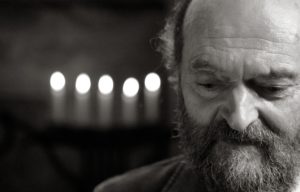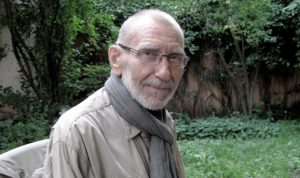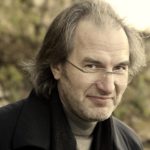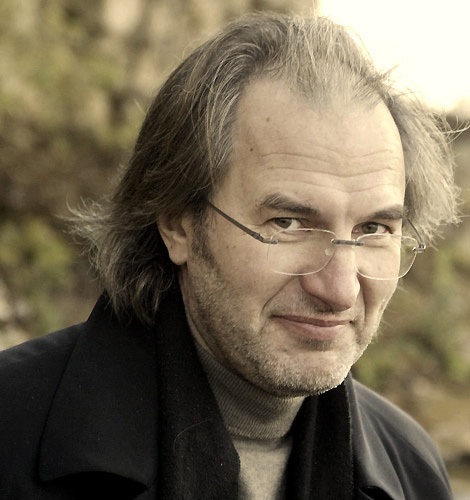By Andrea Angelini, ICB Managing Editor
I met Tõnu Kaljuste in one of the best pizzerias in Rimini, where we had dinner together after spending a long, hard day at the Cesena Conservatory of Music, where, from February 17 to 19, 2011, the famous Estonian artist led a masterclass for singers and conductors focused on the choral music of Arvo Pärt. In repertoire there were some of his most popular songs, like the Magnificat, Da nobis pacem, Which Was The Son of the…. Fans of this repertoire came in great number: the course was attended by 24 participants not only from Italy but from France, Germany and Australia as well. A final concert and the consequent awarding of certificates were the pinnacle of this wonderful experience organized by the managing staff of the Cesena Conservatory in collaboration with the Association Musica Ficta.
Andrea Angelini (AA): What was the most important decision you ever made that fashioned you into the musician you are today?
Tõnu Kaljuste (TK): It has been very important and useful to have composers around me; they gave me an extreme interest in this kind of music. If you study only an instrument, like piano or violin, you find yourself practicing a huge amount of music from the past. But if you have composers beside you, close to you, you find your authentic musical mother language. It was an important message. My father was a children’s choir conductor and music pedagogue. He wrote many books for schools and was a fanatic of the Kodaly system. I sang in his children’s choir and probably the story started there. I don’t know for sure if I decided to become a musician at a specific point in my life or if I felt myself to be a musician from the beginning. It is like when one is travelling on water: the waves take you some place in the world. In my case, it was like that with music.
AA: The music of Arvo Pärt has achieved great popularity in Italy and throughout the world, much more than that other contemporary composers. What are, in your opinion, the reasons that have allowed this kind of success?
TK: Talent, period! Sheer talent. He wrote music during the Sixties, using a collage system with different techniques; he composed songs for children and then changed his mind and started the great tintinnabuli style. Now he has mixed that tintinnabuli style with different things. It’s not important what kind of technique he uses. He is a very good composer!

AA: When we speak about contemporary music, we immediately think of the “Darmstadt school”. That is not a very popular school because people say it doesn’t touch the heart. Was Pärt a scholar of the Darmstadt school before experimenting with the tintinnabuli style? Or what happened?
TK: What happened inside the composer’s mind isn’t ours to know. But if you look at his oldest scores, like the Second Symphony or Pro et contra or Solfeggio for choir, you realize that his compositions are always linked with algebra, with mathematical elements, and are always connected within a very clear system. In later pieces, like Adam’s Lament, he just started to fly with a new power. Surprisingly, all the styles and all the algebra he’d used before – and that was important before – have been transformed in a new way of communication, probably much more free. Once again we come back to the talent of the composer. He is capable of composing good music that touches the heart. He is a communicator of emotions; sometimes he communicates distance from items, sometimes he enters the realm that might be called mysticism, but it is just pure music, a musical independent language with some beautiful elements, that’s the point! He told me, “For my music it is important that you play only one note, beautifully”. But in some music, in some 20th century contemporary music, you can play all the notes beautifully without the music giving you back this kind of feeling, this beauty. That, of course, is a dangerous area for everyone; everyone has their own definition of beauty. This new music always breathes together with the audience.
AA: In concert, do you perform Pärt’s music in your own your way or do you completely follow the thinking of the composer?
TK: I follow his lead and put something of my own into it, too. Some decisions were neither mine nor his but were arrived at together, a new idea. He is a sensitive composer; he usually revises his scores many, many years after their first performance: Da nobis pacem was revised in 2009. When you conduct a piece you have to know which is the last version. These days, it is simple to change a piece — you just have to touch some keys on a computer and you get a new version!
AA: Choral folk music is very popular in Europe. In many countries, especially Hungary, the Baltic and Scandinavian countries, Russia, in the north of Italy and elsewhere, people feel that traditions can be kept and spread through music. How is it possible to attract young people to songs telling them about “a world of the past” that has almost disappeared?
TK: We have to know culture and history in order to understand how the music developed in a given place. Music wasn’t originally made for concert halls. Musical language was part of communication; it helped make words, it helped people live and breathe.
AA: But traditions recall the old; young people are more interested in techno or rock music. How can we interest young people in singing about facts that happened 20, 30, 40, 50 years ago?
TK: I think that every person will have his or her own ideas about this. You can’t stop techno or pop music. We have thousands, millions of people going in that one direction. Whatever type of music is preferred, it’s part of our life and it’s important not to create conflicts between all the different styles. Sometimes they use interesting folklore elements, bringing them to the contemporary world. Maybe there are connections that help people understand what the folklore meant for our culture and history, how the music started, what the elements were. These days the marketing industry is so fantastic, but when people start to understand music, what is it they buy every day? It’s like an autopilot — think about this — sometimes you have a lot of people living connected to the old music and keeping it alive. I think in Europe it may be difficult to understand this theory because the connection between historic folklore and present life is not so fresh, but when you look at Asia or India, for instance, you see how differently we each think, musically speaking. When we are introduced deeply to the “raga” system, we realize, “Wow, how many elements there are in this pattern!” We can’t explain all those elements well but we know we must learn a little bit more about them.
AA: Veljo Tormis and Arvo Pärt at the mirror. What do they represent for Estonia and where is Estonia represented in their works?
TK: I think that every good composer is unique and that he doesn’t belong specifically to one country. Good music is everywhere but, of course, Veljo Tormis is a special Estonian composer because he uses the songs and traditions of our very old Estonian folk music. At the time he started arranging Estonian folk music, well aware of the country’s small size, he wanted to preserve the culture of his little motherland. He was also attracted by the fact that the original Ugro-Finnic language was quite forgotten by people living in a country that had belonged to Russia for many years. When Tormis wrote the six Cycles (Livonian Heritage, Votic Wedding Song, Izhorian Epic, Ingrian Evenings, Vepsian Paths and Karelian Destiny) nobody knew about their genesis. In the past, quite a large population lived here, speaking different now-dead languages, and Tormis thought Estonian would have been the next to go! There was just the power of the musical traditions against this heavy Russian cultural domination. At the time he composed, the folkloric music was being cleaned up using typical romantic arrangements. Sometimes, listening to European folk music, it’s difficult to tell if a song is Danish or German: there are so few differences in the harmonies or arrangements. But the true Estonian folklore gave Veljo Tormis the idea of representing only the original songs without clouding the melody with too much of that typical romantic harmony. I like what Stravinsky did with Russian music and how many composers retained the original folklore. Veljo Tormis “made us up” to reveal our original face. I think he brought the musical language of the Estonian mother language to Estonians. They recognized their own folklore and Veljo Tormis just made it possible for people to sing a tradition that had been forgotten for a long time.

Arvo Pärt works in a completely different area. To make clear with an example: I can say that Veljo Tormis’ direction is “down” (toward the ground) and Arvo Pärt’s direction is up (toward the sky). Sometimes you need to stay low, sometimes you need to fly up to the sky. You can’t forget that both directions, both sides, are very old in Estonian music culture! Then you asked me what they represent for Estonia and whether Estonia is proud of these composers. What can I say? They are like a visiting card for our country, elements of national propaganda, in a good sense! Estonia is so small and without a powerful cultural system as in the United States where composers are held in great esteem and where the government promotes them abroad, like what happened with Bernstein. We have another dimension of the concept of “popularity in the world”.
AA: Arvo Pärt lived abroad for many years of his life; did this fact damage the image of Estonia in any way? Could people consider him to be not a true Estonian cultural representative?
TK: Pärt is more cosmopolitan than Tormis, yet he wrote wonderful music for children in the Estonian language, especially in his youth. Pärt is in a different league: he is Orthodox, for instance. Two different people, but both are very famous in Estonia. Arvo Pärt was a student of Veljo Tormis after the second World War.
AA: Estonia is a small place but big in music. What is the secret to its becoming a “singing country”? How much did the Soviet era affect the wish for freedom through music?
TK: As I mentioned before, those types of songs had existed in Estonian folklore for hundreds of years. The power of song can change the world, can change stones to money, can create magical things. It already existed within our old folklore music but the first time people started to sing together about freedom was when Estonia broke away from the Russian Empire: thousands of singers came to Tartü in the summer of 1869 from all over Estonia, founding – in a spontaneous way – the Laulupidu (Estonian Song Festival), one of the largest amateur choral events in Europe. Estonian nationalism started at that moment. Between the end of the 19th and the beginning of the 20th century, many young composers throughout Europe founded “National Schools” to preserve the typical melodic elements of the music folklore.
AA: Do you think that choral music played an important role in gaining freedom during the Soviet era or was it not so important?
TK: Yes, it was! People didn’t go into the streets to protest, to crash cars, to break glasses… They just came together, singing. The power of music!
AA: In my opinion, a choral piece is a text dressed by music. Tell me about the poetic power of words.
TK: The poetic power comes together with the music. Three great languages meet together: text, literature and music. When the music is good, it surely helps the text to fly. For example, Gregorian Chant has been used in the Church to touch hearts; it features simple but very effective melodies.
AA: “The human voice is the most perfect instrument of all”. Do you agree with this sentence by Arvo Pärt?
TK: Every instrument is perfect! Thinking that the human voice is the highest perfection is so beautiful, but… it depends who plays, and what. Let me say that it is true when all the material works well… But that doesn’t always happen: sometimes singers are the most stretched people in the world. The voice is like a secret: you have it but you can’t touch it like an instrument, like a violin… It’s connected with many things inside the human body. Indeed, every instrument in the world clearly tries to imitate the human voice, when there is a good player behind it…

 Tõnu Kaljuste is the conductor who founded the Estonian Philharmonic Chamber Choir (EPCC) (1981) and the Tallinn Chamber Orchestra (TCO) (1993). He has been a regular Grammy nominee and the winner of several prizes for recordings (Diapason d’Or de l’Année 2000, Cannes Classical Award, Edison Prize). Kaljuste has been a lecturer at the Tallinn Conservatory and a conductor of the Estonian National Opera. He has worked with many orchestras and choirs all over the world. During the 1990’s, besides his work with the EPCC and the TCO, he was also principal conductor of the Swedish Radio Choir and the Netherlands Chamber Choir. Since 2001 he has worked internationally as a freelance conductor. He was appointed a member of the Royal Music Academy of Sweden and has been awarded the Japanese ABC Music Fund Award, the International Robert Edler Prize for Choral Music and the First Prize of the 2004 Estonian Cultural Fund. Kaljuste has dedicated a major part of his work to the music of Estonian composers (Heino Eller, Arvo Pärt, Veljo Tormis, and Erkki-Sven Tüür), whose compositions he has recorded for the ECM record label. He has also recorded all of the vespers and litanies of Wolfgang Amadeus Mozart as well as the church music of Antonio Vivaldi for the Carus Verlag record label. He has worked in collaboration with composers such as Alfred Schnittke, György Kurtag, Krzysztof Penderecki, Erik Bergman, Giya Kancheli, Sven-David Sandström, Knut Nystedt, Einojuhani Rautavaara, Brett Dean, and R. Murray Schafer, among others. In 2004, the new Nargen Opera project theatre began its activities under Kaljuste’s direction. During the 2004-05 season, there were stagings of three of Joseph Haydn’s operas, Jaan Tätte’s play “Lantern” and Veljo Tormis’ “Estonian Ballads”, the latter in a co-production with the Von Krahli Theatre. The 2005-06 season of the Nargen Opera included two chamber operas by composer Tõnu Kõrvits. International engagements during the 2005/06 season included appearances with the Mahler Chamber Orchestra, Brabants Orkest, Malmö Symphony Orchestra, Copenhagen Philharmonic and the Munich Radio Symphony Orchestra and others.
Tõnu Kaljuste is the conductor who founded the Estonian Philharmonic Chamber Choir (EPCC) (1981) and the Tallinn Chamber Orchestra (TCO) (1993). He has been a regular Grammy nominee and the winner of several prizes for recordings (Diapason d’Or de l’Année 2000, Cannes Classical Award, Edison Prize). Kaljuste has been a lecturer at the Tallinn Conservatory and a conductor of the Estonian National Opera. He has worked with many orchestras and choirs all over the world. During the 1990’s, besides his work with the EPCC and the TCO, he was also principal conductor of the Swedish Radio Choir and the Netherlands Chamber Choir. Since 2001 he has worked internationally as a freelance conductor. He was appointed a member of the Royal Music Academy of Sweden and has been awarded the Japanese ABC Music Fund Award, the International Robert Edler Prize for Choral Music and the First Prize of the 2004 Estonian Cultural Fund. Kaljuste has dedicated a major part of his work to the music of Estonian composers (Heino Eller, Arvo Pärt, Veljo Tormis, and Erkki-Sven Tüür), whose compositions he has recorded for the ECM record label. He has also recorded all of the vespers and litanies of Wolfgang Amadeus Mozart as well as the church music of Antonio Vivaldi for the Carus Verlag record label. He has worked in collaboration with composers such as Alfred Schnittke, György Kurtag, Krzysztof Penderecki, Erik Bergman, Giya Kancheli, Sven-David Sandström, Knut Nystedt, Einojuhani Rautavaara, Brett Dean, and R. Murray Schafer, among others. In 2004, the new Nargen Opera project theatre began its activities under Kaljuste’s direction. During the 2004-05 season, there were stagings of three of Joseph Haydn’s operas, Jaan Tätte’s play “Lantern” and Veljo Tormis’ “Estonian Ballads”, the latter in a co-production with the Von Krahli Theatre. The 2005-06 season of the Nargen Opera included two chamber operas by composer Tõnu Kõrvits. International engagements during the 2005/06 season included appearances with the Mahler Chamber Orchestra, Brabants Orkest, Malmö Symphony Orchestra, Copenhagen Philharmonic and the Munich Radio Symphony Orchestra and others.
Edited by Anita Shaperd

